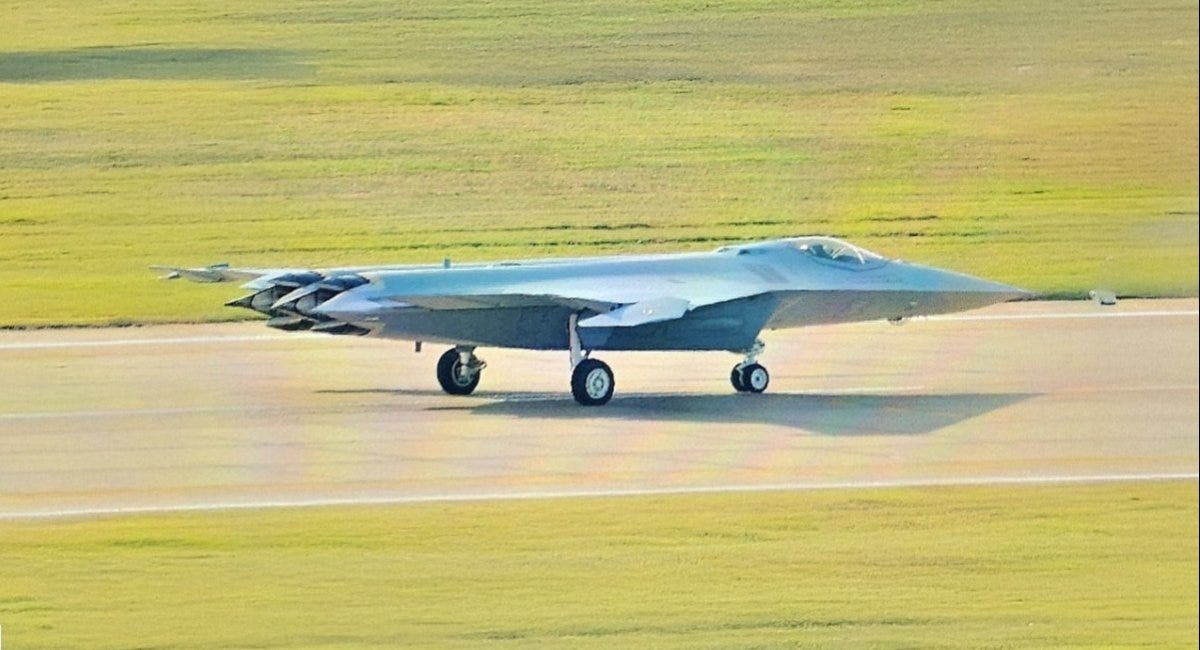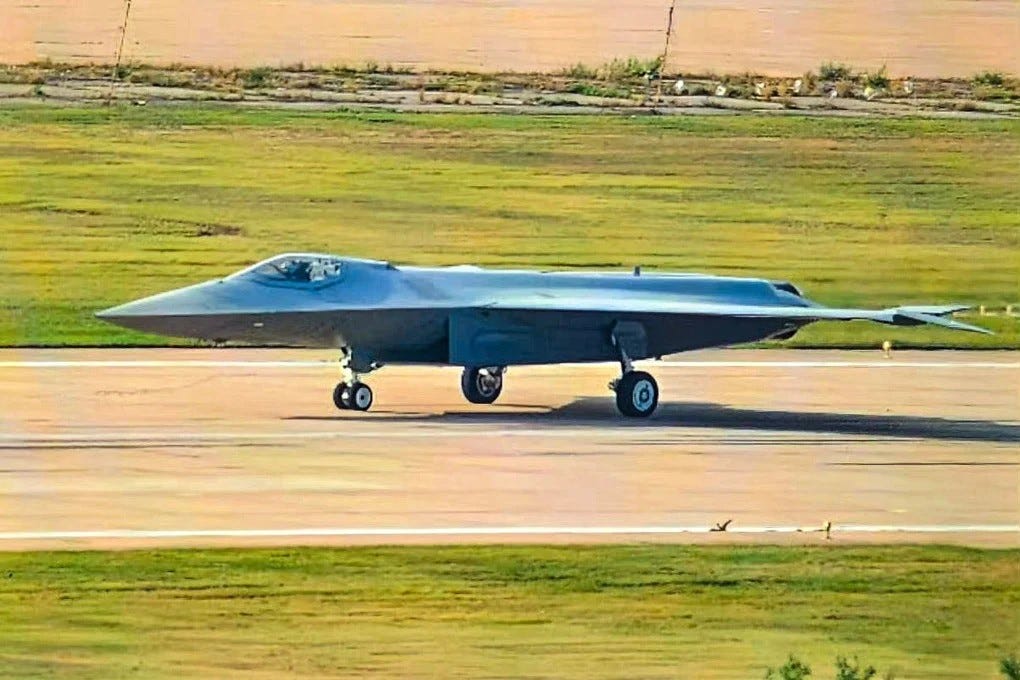Did China Just Leapfrog the United States with 6th Gen Fighters?
It seems like a lot of photos of next-generation aircraft have been leaking out of China lately, doesn’t it?
China loves a good airshow reveal.
Grainy images, shadowy prototypes, whispers of next-generation jets that supposedly put the US on notice.
Their latest head-turner is what defense analysts are calling the J-50, a stealthy, tailless aircraft pitched as a sixth-generation fighter. If you squint at the photos, it looks like something halfway between a flying wing and a sci-fi sketch, the kind of plane you’d expect to see hunting Luke Skywalker over Tatooine.
But is it the dawn of a new era in airpower, or is Beijing just rolling out another propaganda prop?
Let’s pull this apart.
What We’re Supposed to See in the J-50
If the internet sleuths and leaked images are to be believed, the so-called J-50 is China’s grand entrance into the sixth-generation air combat race. The airframe’s design language borrows heavily from every stealth jet that has come before it… but adds a few distinctly experimental twists.
The Tailless “Lambda” Wing
At first glance, the J-50’s most striking feature is its tailless, lambda-shaped planform. It’s a blended body-wing configuration where the fuselage and wings merge into one continuous surface, cutting radar returns from the rear quarter and reducing drag.
The design sacrifices traditional tailplanes for lower observability, forcing the aircraft to rely on advanced flight control algorithms to stay stable. In theory, this should make the jet more slippery on radar than even the F-22 or J-20.
In practice, it’s a pilot’s worst nightmare unless your flight control software is written by the gods of stability augmentation.
Swiveling Wingtips
Next up: those swiveling wingtips. They’re rumored to pivot for additional roll or pitch control, compensating for the lack of horizontal tails. It’s clever, if it works. Think of it like stealth-era ailerons on steroids. The goal is to preserve aerodynamic agility while maintaining the radar-smooth outline of a flying wing. But every moving part is another maintenance headache, and every seam risks bouncing radar waves back toward the enemy.
So, either Beijing’s engineers pulled off something truly elegant… or they’ve just created the world’s most expensive set of power flaps.
Twin Engines and Flat Nozzles
Under the hood, or rather the tail, sit two engines with 2D thrust-vectoring nozzles, flattened to suppress heat signatures and improve stealth from below. The F-22 pioneered this approach, using its nozzles to out-turn anything else in the sky.
The J-50 seems to be copying that formula, though whether its domestically built WS-15-class engines can sustain the power, temperature tolerance, and responsiveness of Pratt & Whitney’s F119s is doubtful.
China’s track record with high-temperature turbine blades and reliable afterburners has been… let’s call it “developing.”
Internal Weapons Bays
Like every modern stealth aircraft, the J-50 appears to feature internal weapons bays with clean, uninterrupted contours.
No dangling missiles, no fuel tanks, no visible seams.
This is about airflow and speed. External stores create drag and light up radar screens. Internal bays let you carry a payload while pretending you’re unarmed. But integrating weapons that deploy cleanly at supersonic speed is a high-risk engineering ballet.
Even the F-35, with twenty years of refinement, still wrestles with bay door timing under load. The J-50’s designers are likely learning those same painful lessons right now.
The Mystery Bulge
Finally, there’s the curious “bulge” beneath the nose… an optical blister that looks suspiciously like a sensor suite.
Analysts suspect it houses an advanced electro-optical/infrared (EO/IR) targeting system, perhaps a Chinese answer to the F-35’s EOTS.
If true, it would give the pilot an omnidirectional thermal picture of the battlespace, useful for tracking enemy aircraft or cruise missiles without lighting up radar. It’s also a hint that China is leaning hard into sensor fusion, combining IR, radar, and data-link inputs into a single cockpit display. But it could just as easily be a dummy fairing added for show. Beijing knows how to stage a reveal.
Taken together, these design features show ambition, not proof.
China wants to signal that it has cracked the stealth-agility paradox, building a jet that can hide, hunt, and out-turn its opponents. Whether the J-50 can actually do any of that outside a prototype or a heavily edited test flight remains the trillion-yuan question.
A stealth jet on the tarmac is one thing. A stealth jet surviving in contested skies against modern radar and missile systems is another.
Propaganda or Progress?
China has a long tradition of unveiling shiny prototypes that serve more as headlines than weapons. Releasing video or carefully staged images of the J-50 sends two messages: to their domestic audience, that the Party is delivering world-class technology, and to foreign militaries, that China is closing the gap with the US.
The problem is, prototypes are not production aircraft. A mock-up can look stealthy while being aerodynamically compromised. A demonstrator might fly, but without the sensor fusion, mission systems, or stealth coatings that make it lethal.
Add in China’s flair for camera tricks: low-angle lighting, clean paint jobs, no engine heat distortion, and skepticism is warranted.
We should assume the J-50 exists in some form. But does it fight like a sixth-gen fighter?
Meh… Not yet.
Did Beijing Leapfrog Washington? Or Just Copy Smarter?
Let’s kill the myth right now: China didn’t wave a magic wand and leapfrog US aviation technology. What they’ve done is more like methodical catch-up homework: painstaking, opportunistic, and powered by sheer industrial persistence.
For decades, China has been accused of siphoning Western military technology through every means short of walking out the front door with blueprints under their arm.
Industrial espionage, cyber intrusions, front companies acquiring dual-use tech, and a robust gray-market trade in components have all played their part. If you can get your hands on a radar-absorbent coating sample or the schematics for composite fuselage construction, you don’t have to invent from scratch; you just have to replicate.
That’s not a generational leap, it’s a shortcut.
Western defense firms know this all too well, and the Pentagon has spent years hardening supply chains against it, but the damage has been done.
China has already absorbed enough foreign DNA to seed its own stealth lineage.
Also, stealth is not just about how a jet looks under a spotlight. A radar-evading shape is the starting point, but it’s the invisible systems underneath: thermal suppression, sensor fusion, high-bandwidth data links, and integrated avionics.
These determine whether a fighter survives first contact with modern air defenses.
These “enablers” are where Beijing has poured decades of cash and brainpower. They’ve built up domestic composites manufacturing, invested heavily in indigenous microelectronics, and pushed for breakthroughs in radar-absorbent materials.
Are they leading? Not yet. But the margin of difference between “good enough” and “dominant” is shrinking, and China is closing that gap year after year.
Keep reading with a 7-day free trial
Subscribe to Eyes Only with Wes O'Donnell to keep reading this post and get 7 days of free access to the full post archives.




